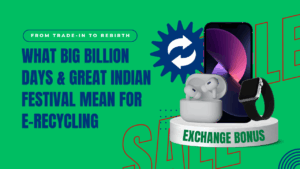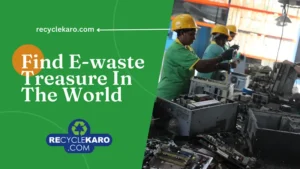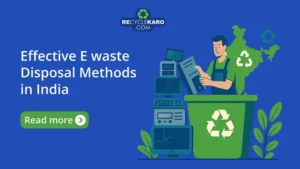10 Ways to Reduce E-Waste in India [2025]

India generates over 3.2 million tonnes of electronic waste annually, per the Central Pollution Control Board (CPCB) 2023 report, making it critical to reduce e-waste. With only 10% of e-waste recycled formally, strategies to reduce e-waste are essential for environmental protection and resource conservation. This blog outlines actionable ways to reduce e-waste in India, tailored for individuals, businesses, and policymakers, using proven methods to reduce e-waste effectively.
Key Takeaways to Reduce E-Waste in India
- Act now: Repair, recycle, or donate to reduce e-waste effectively.
- Choose wisely: Support brands and recyclers like Recyclekaro to reduce e-waste.
- Raise awareness: Educate others on how to reduce e-waste in India.
- Leverage technology: Use AI and blockchain to reduce e-waste efficiently.
- Engage communities: Join drives to reduce e-waste collectively.
By implementing these ways to reduce e-waste, you can contribute to a sustainable India.
What Is E-Waste and Why Must You Reduce E-Waste?
E-waste includes discarded electronic devices like smartphones, laptops, and appliances containing hazardous materials such as lead and mercury. To reduce e-waste in India, understanding its impact is key. Improper disposal pollutes soil and water, with 90% of e-waste handled informally, per CPCB data. Efforts to reduce e-waste conserve resources and align with India’s E-Waste Management Rules, 2022, promoting sustainability.
- Environmental impact: Reducing e-waste prevents toxic leaks into ecosystems.
- Health risks: Informal recycling exposes workers to harmful substances.
- Resource savings: Recycling recovers materials, reducing e-waste and mining needs.
Key Takeaway: You can reduce e-waste by adopting responsible disposal habits.
How to Reduce E-Waste: 10 Practical Ways to Reduce E-Waste in 2025
To reduce e-waste in India, follow these 10 practical ways to reduce e-waste, designed for accessibility and impact:
- Extend Device Lifespan: Repair devices to reduce e-waste instead of replacing them. A 2024 IIT Delhi study shows this can reduce e-waste by 15%.
- Choose Sustainable Brands: Buy from companies like Recyclekaro that reduce e-waste through take-back programs.
- Donate Functional Devices: Donate old gadgets to NGOs to reduce e-waste and support communities.
- Use Authorised Recyclers: Partner with CPCB-registered recyclers to reduce e-waste safely.
- Buy Refurbished Electronics: Opt for certified refurbished devices to reduce e-waste production.
- Avoid Overbuying: Assess needs to reduce e-waste from unused gadgets.
- Join E-Waste Drives: Participate in local drives to reduce e-waste accumulation.
- Support the Circular Economy: Lease electronics to reduce e-waste from ownership.
- Raise Awareness: Educate others on how to reduce e-waste and its benefits.
- Advocate for Compliance: Push businesses to reduce e-waste via regulatory adherence.
Key Takeaway: These ways to reduce e-waste empower you to act sustainably.
Why Is Reducing E-Waste a Priority in India?
India’s e-waste crisis grows due to rapid electronics consumption and limited recycling infrastructure. To reduce e-waste, addressing its causes is crucial.
In 2024, India’s electronics market grew by 8%, per Statista, increasing e-waste. Only 22% is collected formally, leaving informal recyclers to handle most e-waste unsafely. Reducing e-waste mitigates health and environmental risks.
Factor Impact Solution Urban demand Cities generate 30% of e-waste Expand recycling to reduce e-waste Informal recycling Causes health risks Promote formal systems to reduce e-waste Low awareness Increases improper disposal Educate to reduce e-waste Solution: Formal recycling and awareness campaigns are key to reducing e-waste.
How to Reduce E-Waste in India at Home?
You can reduce e-waste at home by repairing devices, using e-waste bins, and donating gadgets. For example, repairing a phone screen costs ₹2,000–₹5,000, compared to ₹20,000 for a new phone, helping reduce e-waste. Drop old electronic devices at Recyclekaro’s collection points to reduce e-waste safely. Avoid hoarding electronic equipments to reduce e-waste accumulation.
- Repair: Extends device life, reducing e-waste.
- Recycle: Use authorised bins to recycle e-waste safely.
- Donate: Give functional devices to reduce e-waste in landfills.
Pro Tip: Locate e-waste bins via https://www.recyclekaro.com/ to reduce e-waste.
How Can Businesses Implement Ways to Reduce Electronic Waste?
Businesses can reduce e-waste by adopting sustainable IT policies. Leasing devices reduces e-waste by ensuring recycling at end-of-life. Partnering with recyclers like Recyclekaro helps businesses reduce e-waste through bulk disposal. Training employees on how to reduce e-waste ensures compliance with India’s 2022 regulations, reducing e-waste by 20%, per a 2024 Nasscom report.
- Leasing: Minimises ownership, reducing e-waste.
- Recycling partnerships: Safely reduce e-waste volumes.
- Training: Ensures staff reduce e-waste effectively.
Key Takeaway: Businesses can reduce e-waste by integrating sustainability into operations.
What Role Do Manufacturers Play in Efforts to Reduce E-Waste?
Manufacturers can reduce e-waste by designing durable, repairable products and offering take-back programs. Brands like Samsung recovered 10,000 tonnes of e-waste in 2024, per CPCB, helping reduce e-waste. Modular designs, like Fairphone’s, reduce e-waste by allowing part replacements. Compliance with EPR ensures manufacturers reduce e-waste across product lifecycles.
- Modular designs: Reduce e-waste through repairs.
- Take-back programs: Encourage recycling to reduce e-waste.
- EPR compliance: Holds producers accountable to reduce e-waste.
Actionable Step: Choose brands committed to reducing e-waste for purchases.
How to Choose a Recycler to Reduce E-Waste in India?
Selecting a CPCB-certified recycler ensures you reduce e-waste safely. Recyclekaro helps reduce e-waste with transparent processes. Verify certification on the CPCB website and confirm local accessibility to reduce e-waste effectively. Avoid informal recyclers to reduce e-waste-related to environmental harm.
| Criteria | Importance | Verification |
| Certification | Ensures compliance to reduce e-waste | Check the CPCB site |
| Transparency | Confirms safe processes to reduce e-waste | Request details |
| Accessibility | Simplifies disposal to reduce e-waste | Confirm locations |
Pro Tip: Use Recyclekaro’s website to reduce e-waste via nearby centres.
What Are the Benefits of Reducing E-Waste in India?
Efforts to reduce e-waste conserve resources, protect health, and promote sustainability. Recycling one million laptops saves energy for 3,600 homes annually, per a 2023 UN report, helping reduce e-waste impacts. Recovering valuable materials like gold reduces e-waste and mining needs. Safe disposal reduces e-waste pollution in communities.
- Environmental gain: Reduces e-waste in landfills.
- Economic benefit: Lowers costs by reducing e-waste.
- Health protection: Minimises toxic exposure via reduced e-waste.
Key Takeaway: Reducing e-waste supports India’s sustainability goals.
How Does Recyclekaro Help Reduce E-Waste in India?
Recyclekaro, a CPCB-registered leader in e-waste management, offers innovative services to reduce e-waste across India. Processing 50,000 tonnes of e-waste annually, Recyclekaro provides scrap collection, EPR credit solutions, and specialised lithium-ion battery recycling to reduce e-waste effectively. These services help individuals, businesses, and manufacturers reuse e-waste while complying with regulations.
- Scrap Collection: Recyclekaro’s nationwide network simplifies e-waste disposal. You can schedule pick-ups or drop off devices at collection points to reduce e-waste. In 2024, Recyclekaro collected 12,000 tonnes of scrap, reducing e-waste in cities like Delhi and Mumbai.
- EPR Credits: Recyclekaro supports manufacturers in meeting Extended Producer Responsibility (EPR) targets under the E-Waste Management Rules, 2022. By purchasing EPR credits, businesses offset their e-waste obligations, helping reduce e-waste. Recyclekaro facilitated 5,000 tonnes of EPR-compliant recycling in 2024, per CPCB data.
- Lithium-Ion Battery Recycling: With electric vehicle adoption rising, lithium-ion battery waste is a growing concern. Recyclekaro’s advanced facilities recover 95% of battery materials, like cobalt and lithium, to reduce e-waste, per a 2024 IIT Bombay study. This process minimises environmental harm and supports India’s clean energy goals, reducing e-waste from batteries.
- Why Choose Recyclekaro?: Recyclekaro’s transparent processes and blockchain-based tracking ensure safe disposal, helping you reduce e-waste responsibly. Their partnerships with NGOs and municipalities amplify efforts to reduce and reuse e-waste through community drives.
Actionable Step: Visit https://www.recyclekaro.com/ to schedule a scrap pick-up or purchase EPR credits to reduce waste. For battery recycling, contact Recyclekaro for specialised services to reduce e-waste from lithium-ion batteries.
Key Takeaway: Recyclekaro’s comprehensive solutions make it easy to reduce e-waste through professional recycling services.
How Do India’s E-Waste Rules Help Reduce E-Waste?
The E-Waste Management Rules, 2022, mandate actions to reduce e-waste through EPR, requiring producers to collect 60% of e-waste by 2025. These rules promote awareness and formal recycling to reduce e-waste. In 2024, compliance increased formal collection by 15%, per CPCB, helping reduce e-waste effectively.
- EPR targets: Drive collection to reduce e-waste.
- Awareness: Educates consumers to reduce e-waste.
- Penalties: Enforce compliance to reduce e-waste.
Actionable Step: Support brands that reduce e-waste via regulatory adherence.
How Can Communities Reduce E-Waste in India?
Communities and NGOs can reduce e-waste through awareness campaigns and collection drives. Toxics Link’s programs educate residents to reduce e-waste, while Bengaluru drives collected 5,000 tonnes in 2024, reducing e-waste locally. Schools can host bins to reduce e-waste among students.
- Campaigns: Teach how to reduce e-waste.
- Drives: Simplify disposal to reduce e-waste.
- Youth involvement: Encourages efforts to reduce e-waste.
Pro Tip: Partner with Recyclekaro to reduce e-waste via local drives.
What Challenges Hinder Efforts to Reduce E-Waste in India?
Low awareness, limited infrastructure, and informal recycling hinder efforts to reduce e-waste. Only 30% of Indians understand e-waste risks, per a 2024 Recyclekaro survey, impeding efforts to reduce e-waste. Rural areas lack facilities, and 70% of e-waste is handled informally, increasing risks.
| Challenge | Impact | Solution |
| Low awareness | Increases improper disposal | Campaigns to reduce e-waste |
| Limited infrastructure | Restricts recycling access | Expand facilities to reduce e-waste |
| Informal recycling | Causes health risks | Formal systems to reduce e-waste |
Solution: Education and infrastructure can reduce e-waste effectively.
How Can Technology Help Reduce E-Waste in India?
Technology aids efforts to reduce e-waste through AI, blockchain, and modular designs. AI improves recycling efficiency by 25%, per a 2024 IIT Bombay study, helping reduce e-waste. Blockchain tracks e-waste to reduce losses, as piloted by Recyclekaro. Cloud software reduces e-waste by minimising hardware upgrades.
- AI: Enhances sorting to reduce e-waste.
- Blockchain: Ensures transparency to reduce e-waste.
- Cloud solutions: Extend device life to reduce e-waste.
Key Takeaway: Technology streamlines ways to reduce electronic waste.
Frequently Asked Questions About Reducing E-Waste in India
1. How Can Rural Areas Reduce E-Waste Effectively?
Rural areas can reduce e-waste by partnering with recyclers like Recyclekaro for mobile collection units. In 2024, Recyclekaro’s rural drives collected 2,000 tonnes, helping reduce e-waste despite limited infrastructure.
2. What Role Do Youth Play in Reducing E-Waste?
Youth can reduce e-waste by organising school-based e-waste drives and spreading awareness online. A 2024 Toxics Link campaign saw 5,000 students collect 500 tonnes, showing ways to reduce e-waste.
3. How Does India’s E-Waste Compare Globally?
India generates 3.2 million tonnes of e-waste annually, third globally after China (10 million tonnes) and the USA (7 million tonnes), per 2023 UN data. Formal recycling helps reduce e-waste effectively.
4. Can Upcycling Reduce E-Waste in India?
Upcycling transforms old electronics into new products, like turning circuit boards into art. This creative approach can reduce e-waste by 5%, per a 2024 IIT Delhi study, offering unique ways to reduce electronic waste.
5. How Do E-Waste Laws Differ Across Indian States?
While the E-Waste Management Rules, 2022, apply nationally, states like Karnataka enforce stricter collection targets, helping reduce e-waste by 10% more than others, per CPCB 2024 data.
6. What Are the Economic Incentives to Reduce E-Waste?
Recycling recovers ₹50,000 worth of materials per tonne of e-waste, per a 2024 Recyclekaro report, incentivising businesses to reduce e-waste through partnerships with recyclers like Recyclekaro.
7. How Can Small Businesses Reduce E-Waste Cost-Effectively?
Small businesses can reduce e-waste by leasing devices and using Recyclekaro’s affordable scrap collection, saving 30% compared to new purchases, per a 2024 Nasscom study.
8. Why Is Lithium-Ion Battery Recycling Critical to Reduce E-Waste?
Lithium-ion batteries contain toxic chemicals that harm ecosystems if not recycled. Recyclekaro’s 95% material recovery rate helps reduce e-waste and supports India’s EV growth, per a 2024 IIT Bombay study.
9. How Do E-Waste Exports Impact Efforts to Reduce E-Waste?
Exporting e-waste to countries with lax regulations increases global pollution. India’s 2022 rules aim to reduce e-waste exports by 20%, per CPCB, keeping recycling local.
10. Can Public-Private Partnerships Reduce E-Waste?
Partnerships between municipalities and recyclers like Recyclekaro can reduce e-waste by 25% through joint drives, as seen in Mumbai’s 2024 initiatives, collecting 3,000 tonnes.
Key Takeaway: These FAQs highlight diverse ways to reduce e-waste in India, from rural access to global comparisons.
Conclusion
Reducing e-waste in India is achievable through collective action, from repairing devices to partnering with recyclers like Recyclekaro. By adopting the 10 ways to reduce e-waste, leveraging technology, and supporting policies like the E-Waste Management Rules, 2022, you can help reduce e-waste, conserve resources, and protect health. Start today by scheduling a scrap pick-up with Recyclekaro to reduce e-waste and contribute to a sustainable future.
Organisation: Recyclekaro (https://www.recyclekaro.com/) leads efforts to reduce e-waste with sustainable recycling solutions, including lithium-ion battery recycling and EPR services.





You can find all the useful information you need on the Vavada mirror. Find out why players switch to the official Vavada website via the mirror, and discover the benefits: similar registration and login processes, bonuses, promo codes